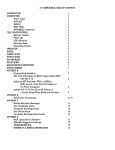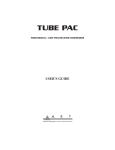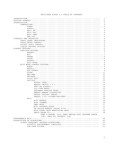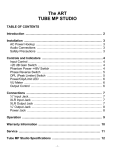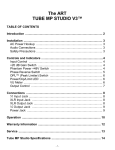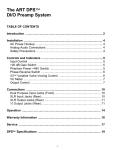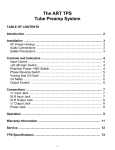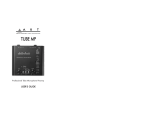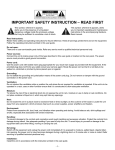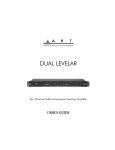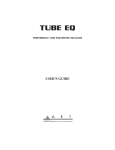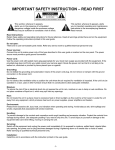Download Art DUAL MP User`s guide
Transcript
DUAL MP Two Channel Tube Microphone Preamplifier USER’S GUIDE Introduction Thank you for purchasing the Dual MP - and congratulations: You now own one of the most sophisticated pieces of audio signal processing available. Offering a superb level of sound quality, the Dual MP’s special tube and integrated circuit design combined with a straightforward user interface quickly and easily gives you access to all of its features. Features The A R T “SOUND”! - (not available elsewhere) Two independent channels of operation XLR balanced inputs and outputs 1/4” TS unbalanced inputs and outputs Hybrid- 12AX7/ quad transistor gain stages +48V Phantom power Phase Reversal 20dB gain switch Independent input and output level controls Four stage “sonic character” LED Array >60dB of gain >100dB dynamic range Internal power supply Front panel instrument/ line input jacks All steel construction Designed and manufactured in the USA Fill in the following for your future reference: Date of purchase: ___________________ Purchased From: ____________________ Serial Number: 254-________ This a great time to fill out the User Registration card included with you Dual MP to become a completely informed A R T Artist. Return-ing the card to us ensures you of becoming the first to know about new A R T products as well as any further developments from A R T. 1 We’re Online! Connections For Product information, questions, applications, tips, answers and general discussion with A R T employees look for A R T on the Internet.. It’s easy to interface the Dual MP with other equipment. XLR input and output connectors are located on the rear panel. Additional 1/4” unbalanced outputs are located on the rear panel and 1/4” instrument/ line inputs are located on the front panel for accessibility. Look for the A R T folder on America Online in Craig Anderton’s Stage Studio and Sound (keyword “SSS”) under the Manufacturer Supported Forums. Email us at [email protected] Look for the A R T supported area in the MIDI Forum B area on Compuserve (Go MIDI). Compuserve address: 76702,3700. Email us at [email protected] Check out our Web Page at: http:\\www.artroch.com The Dual MP’s XLR connectors follow the AES standard of: Pin 1 = Ground, Pin 2 = Hot (+), Pin 3 = Cold (-). Ideally, one input per channel should be used at a time. However, because of its design the Dual MP can be hardwired into a rack without having to disconnect the XLR inputs when using the front panel jacks. If no load is placed on the XLR input (no instrument or microphone connected) the front jack will function as if there was nothing connected to the XLR input. Both Dual MP inputs may be used simultaneously. However, the two signals will sum and the signal present at the XLR jack will tend to attenuate the signal of the 1/4” input. Both balanced and unbalanced output connections may be used simultaneously. This is particularly useful when using the Dual MP as a direct box for instruments or line level signals. **Note: If you experience a grounding hum when using both output connectors (one to the console, one to an instrument amp) simultaneously, a ground loop may be the problem. To remedy this problem, disconnect the ground wire (pin 1) from the XLR cable plugged into the Dual MP’s output. This interrupts the ground path and therefore breaks the loop. Controls, Switches and Indicators Power The Dual MP is powered by an internal power supply. The Power switch and indicator LED are located on the front panel. If the attached power cord ever becomes damaged, discontinue use until you can have it repaired. Phantom Power Switch Each channel of the Dual MP can power any microphone needing +48 volts DC of Phantom power. The Phantom power is engaged and disengaged with this switch. Phantom power is supplied to pins 2 and 3 of the XLR input jack. 2 3 Input Control The input control sets the amount of input gain of the Dual MP. Turn the control clockwise to increase gain and counterclockwise to decrease gain. You may control two ranges of gain with this control, +26 to +60dB and +6 to +40dB. Selection of the gain range is made with the +20dB gain switch. Sonic Character LED Array Four LEDs are provided on each channel which display how the tube gain is affecting the input signal. These LEDs are calibrated with the tube circuitry to give you an accurate visual of its output signal (**Note: these LEDs are pre - output level control). The first LED is labeled Cln (clean). The tube is producing a clean output when this LED is lit. The next two LEDs are labeled “warm”. This is the normal operating range for the Dual MP. At this level, the tube is producing an output signal which most would call “warm” or (those ever over-used) “tube/ retro/ vintage/ rich/ etc/ etc”. Whatever you would like to call it is fine. You’ll find the output signal has an enhanced bottom to low mid quality with smooth high frequency detail. The last LED is labeled “Clp” (Clip). This LED will light at approximately 6dB before audible distortion occurs. If this light flickers, do not panic. The unique design of the Dual MP causes the tube to distort well before any other gain stage. When a tube goes into distortion it is a gradual process and tends to sound pleasing for a range before it turns into a distortion box. After some use you’ll find the “sweet spot” of the Dual MP is with this light flashing fairly regularly. +20dB Gain/ Norm Switch Use the +20dB Gain/ Norm switch to set the gain range of the Input control. When the switch is in the out (Normal) position the gain range is +6 to +40dB. Depressing the switch adds 20dB of gain. With the switch in, the gain range is +26 to +60dB. With most microphone applications you’ll find using the Dual MP with the +20dB gain switch in is needed in most situations. Use the setting that best fits your application. 4 **Note: Be sure to turn down or mute the output of the Dual MP when engaging or disengaging Phantom power. Additionally, when disengaging, allow 30 - 45 seconds for the power to completely dissipate. Most microphones will make a sound like air leaking from a tire when phantom power is disconnected, but some can make some very nasty low rumbles and whines as well. **Another Note: Dynamic microphones should not be affected or damaged if they are plugged into a line where Phantom power is present. However, if the mic doesn’t need it, don’t use it. Some things are best left untested! Phase Switch The Phase switch is provided to reverse the phase of a signal. This switch works on Pins 2 and 3 of the XLR Output jack of the channel. In the Normal position, the signal is in-phase. In the Reverse (or “in”) position, Pins 2 and 3 are reversed as the signal is changed to 180 degrees out of phase. In multiple microphone applications, the placement of the microphones can affect the phase of a signal. If two microphones pick up the same signal from different locations, the result can be a hollow or frequency “shifted” sound. In some cases it may sound as if an instrument disappears if it happens to be 180 degrees out of phase. Depressing the Phase switch of one channel can remedy this problem. Likewise, if a microphone cable is wired incorrectly, when used with a properly wired cable the signal will be out of phase. **Note: for single microphone applications switching the phase switch in and out will produce little to no change in the output signal. Special Effects For industrial, metal, or just “flavor” textures experiment with the Dual MP. Cascading the channels can produce overdrive and tube distortion that can add interesting textures when blended with vocals and different instruments. Placing signals purposely out of phase can yield interesting results. No harm will come to the Dual MP with this type of experimentation however, be sure to have output and monitoring levels turned 5 Output Control The output control sets the output level of the Dual MP. When the control is fully counterclockwise, there is no output.Turning the control clockwise increases the level of the output to a maximum of +10dB of gain. This gain is in addition to the existing input gain. Design Overview A R T’s Dual MP circuitry is a hybrid design utilizing the latest and most advanced solid state and tube technology. Using a transformerless design throughout, the Dual MP maintains exceptional signal integrity and extremely low noise. The Active balanced input utilizes a hybrid multiple paired transistor design providing extremely low noise and excellent CMRR. A second stage 12AX7A tube running on a regulated DC voltage of +50volts provides additional gain. The tube will overload before the input or output stage. This allows the user to manipulate the tube gain to meet their sonic requirements. The 1/4” input has a high impedance preventing the loading of any device connected to it, making the Dual MP perfect for DI applications. Applications Preamp The main application of the Dual MP is a microphone preamplifier. Plug any microphone directly into either input and set the input and output controls to provide a healthy level into the next stage of your system. DI The Dual MP is ideal for use as a DI box. Plug the instrument into either input and use the XLR or 1/4 (or both) outputs to connect to your recorder, board or PA system. DOWN before “testing” the sound. When running one channel into another (cascading) you have the potential for upwards to 120 to 140dB of gain. A R T Dual MP Specifications Dimensions: 1.75” H x 19” W x 6.5” D Input Connections: XLR (balanced), 1/4” unbal. Output Connections: XLR (balanced), 1/4” unbal. Input Impedance: XLR, 1/4” 2K ohms, 840K ohms Output Impedance: XLR, 1/4” 600 ohms, 300 ohms Maximum Input Level: XLR +14dBu Maximum Input Level: 1/4” +22dBu Maximum Output Level: XLR +28dBu Maximum Output Level: 1/4” +22dBu CMRR >75dB (typical @ 1kHz) Frequency Response 10Hz to 20kHz (+0, -1dB) Dynamic Range >100dB (20Hz to 20kHz) Total Harmonic Distortion(THD) <0.1% (typical) Maximum Gain: XLR to XLR 70dB (typical) 1/4” to 1/4” 54dB (typical) XLR to 1/4” 64dB (typical) 1/4” to XLR 60dB (typical) Equivalent Input Noise (EIN) XLR to XLR -129dBu (‘A’ weighted) 1/4” to 1/4” -105dBu (‘A’ weighted) Power Requirements: 95-125VAC, 10W - (USA) Internal fuse Other power requirements configured for country of destination. 2-mix Because of its low noise and excellent tonal qualities, the Dual MP is ideal for running mixes through before recording to DAT or cassette. Used as a mastering device, the Dual MP is capable of adding warmth and, set properly, gentle tube compression to the incoming signal. 6 7 Warranty and Service Information Service Limited Warranty Warranty service for this unit will be provided by Applied Research and Technology, Inc. in accordance with the following warranty statement. The following information is provided in the unlikely event that your unit requires service. Use this procedure to return units in the United States only. For service outside the United States, please contact your authorized A R T distributor. Applied Research and Technology, Inc. (A R T) warrants to the original purchaser that this product is free from defects in workmanship and materials for a period of three years from the date of purchase. A R T will, without charge, repair or replace, at its option, defective product or component parts upon prepaid delivery to the factory service department or authorized service center, accompanied by proof of purchase date in the form of a valid sales receipt. 1) Be sure the unit is the cause of the problem.Check to make sure the unit has power supplied, the proper power supply is being used (note the output specification of the power supply make sure you are using the proper AC or DC voltage), all cables are connected correctly, and the cables themselves are in working condition. EXCLUSIONS: This warranty does not apply in the event of misuse or abuse of the product or as a result of unauthorized alterations or repairs. This warranty is void if the serial number is altered, defaced or removed. A R T reserves the right to make changes in design and make additions or improvements upon this product without any obligation to install the same on products previously manufactured. A R T should not be liable for any consequential damages, including without limitation damages resulting from the loss of use. Some states do not allow limitation of incidental or consequential damages, so the above limitation or exclusion may not apply to you. This warranty gives you specific rights and you may also have other rights which vary from state to state. For units purchased outside the United States, service will be provided by an authorized distributor of A R T products. 2) If you find the unit to be at fault, write down a description of the problem, including how and when the problem occurs. 3) Call the factory for a Return Authorization (RA) number. 4) Pack the unit in its original carton or reasonable substitute. The packing box is not recommended for a shipping carton. Put the packaged unit in another box for shipping. Print the RA number clearly under the address. 5) Include with your unit: a return shipping address (we cannot ship to a P.O. Box), a copy of your purchase receipt, a daytime phone number and the description of the problem. 6) Ship the unit to: Applied Research and Technology, Inc. 215 Tremont Street Rochester, NY 14608 Atten: Repair Department R.A.# _______________ 7) Contact our Customer Service department at 716/436-2720 for your Return Authorization number or questions regarding your repair. Customer Service hours are Monday through Friday 8:30AM to 4:30PM Eastern time. 8 9 Additional Information If you are planning to purchase additional equipment for your audio needs, please consider the following A R T Products. Recording/ Live Sound MR-1, Personal Reverb Processor Tube MP, Personal Microphone Preamplifier MDM-8L, Eight channel compressor/limiter Pro Gate, Eight channel programmable Noise Gate SC-2, two channel compressor/limiter/gate MDC-2001, Stereo dynamics processor FXR and FXR Elite (II), Two channel Digital multi-effects processors Effects Network, Digital Dedicated and multi-effects processor Multiverb Alpha, Digital multi-effects processor HD-15, Two channel 15 band EQ HD-31, 31 band EQ Pro MP, Professional two channel microphone preamp Instrument applications XTREME, Personal guitar processor with digital effects DST-4, Programmable guitar preamp with digital effects Power Plant, Studio guitar preamp DST 8080, 80 watt/ channel powered guitar preamp with effects The Acoustic, Personal acoustic guitar processor with digital effects SGX-2000, Analog and digital preamp/ processor for guitar SGX-Nightbass, Analog and digital preamp/ processor for guitar ECC, Guitar floor processor BCC, Bass floor processor MIDI X-15, MIDI foot controller with two expression pedals X-12, MIDI foot controller with optional Power Pedal controller For a full line catalog, write, call in, or email us to request one. For up to date information on new products send in your User Registration card NOW! 10







